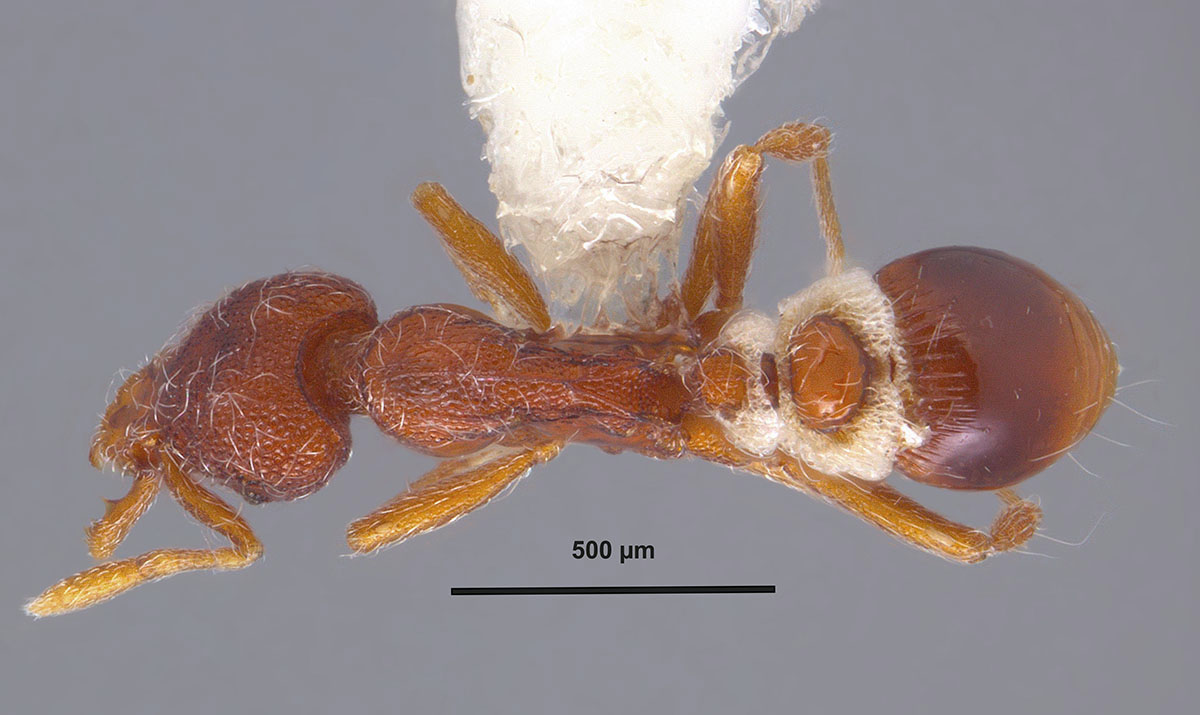Subfamily MYRMICINAE Tribe ATTINI Strumigenys filirrhina (Brown) 1950 |
|
Strumigenys filirrhina, full face view of worker (click photo to enlarge). |
Strumigenys filirrhina, side view of worker (click photo to enlarge). |
Strumigenys filirrhina, label data |
Strumigenys filirrhina, dorsal view of worker (click photo to enlarge). |
Introduction Strumigenys filirrhina is a rarely collected species in the clypeata group. Taxonomic History (provided by Barry Bolton, 2013)
Identification
TL 2.0–2.2, HL 0.56–0.58, HW 0.38–0.40, CI 67–69, ML 0.08–0.09, SL 0.27–0.29, PW 0.24–0.26, WL 0.52–0.55 (measurements and description from Bolton (2000)).Mandibles triangular, serially dentate from clypeal border; following a triangular basal lamella, dentition of principal tooth row with 5 sharp triangular teeth, of which tooth 3 is the longest, then two small teeth, four denticles, and a small apical tooth. Leading edge of scape with setae that all curve toward apex of scape. Clypeus bimarginate around anterior and lateral borders (as seen in full-face view) with upper and lower margins; lower margin projects out beyond the upper margin, the area between the margins with a concave groove. Propodeum with triangular teeth with lamella on each side. Spongiform appendages well developed on dorsum and ventral portions of petiole and postpetiole; first gastral tergite with narrow band of weak spongiform tissue present basally. Setae on anterior and lateral clypeal margins fine, filiform with at least the pair closest to midline (and sometimes others) curving slightly away from midline. Clypeal dorsum in profile with a pair of very long erect flagellate setae arising in front of antennal socket. Dorsolateral margin of head with 2–3 pairs of flagellate setae. Pair of flagellate setae on near occipital margin, a pair on pronotal dorsum, and a pair on mesonotum. General pilosity of head very fine, elongate, and curved to midline of head; pronotal setae similarly simple to narrowly spatulate; mesosomal dorsum, first gastral tergite, and outer surface of hind basitarsus with flagellate setae. Clypeal dorsum smooth, dorsum of head behind clypeus reticulate-punctate; pleurae, side of propodeum, and postpetiole disc smooth, remainder of mesosoma and petiole disc with reticulate-punctate sculpture; first gastral tergite with striae basally, then becoming smooth. Strumigenys filirrhina is most similar to S. bimarginata from which it differs by having flagellate setae in front of antennal sockets, on dorsolateral margins of head, and cephalic dorsum and by its ground pilosity being simple instead of clearly flattened or split at apices of setae. Biology and Economic Importance Distribution Literature Cited Bolton, B. 1999. Ant genera of the tribe Dacetonini (Hymenoptera: Formicidae). Jour. Nat. Hist. 33: 1639-1689. Bolton, B. 2000. The ant tribe Dacetini. Mem. American Entomol. Inst. 65:1-1028. Bolton, B. 2013. Bolton World Catalog Ants. Available online: http://www.antweb.org/world.jsp. Accessed 16 April 2013. Brown, W. L. 1950. Preliminary description of seven new species of the dacetine ant genus Smithistruma Brown. Transactions of the American Entomological Society76: 37-45. Links |
|






